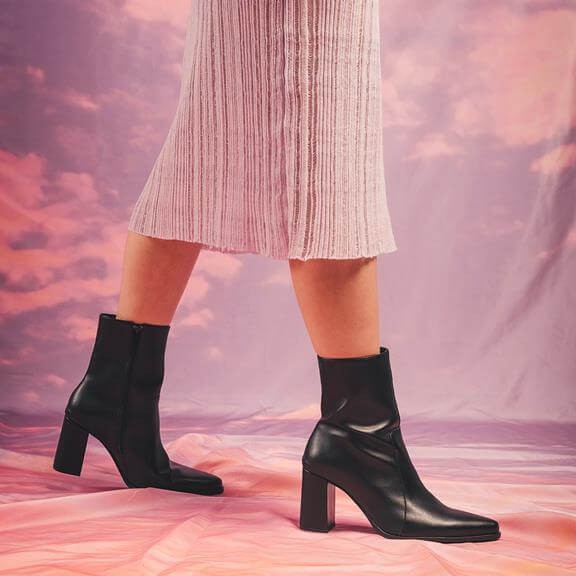- Clothes
- Bags
- Accessories
-
Inspiration
- Shoes
What’s the Most Eco-Friendly Vegan Leather? (And Which Ones to Avoid!)

Vegan leather is undeniably more ethical in the sense that it’s cruelty-free. Does that make it more environmentally friendly than cow leather, though?
Not necessarily. In some cases, vegan leather is even worse for the planet! Not always, luckily, but it’s not a simple black-and-white answer either.
So, to help you make your cruelty-free wardrobe even more sustainable, we’ll show you what we consider the least and most eco-friendly vegan leather types.
Sustainability pros and cons of the most common types of vegan leather alternatives
The main ethical problems with traditional leather are:
- It relies on livestock, which is the world’s largest user of agricultural resources and lands, one of the main causes of deforestation, and contributes to 11%–17% of all greenhouse gas emissions
- It’s not always a by-product! Due to high demand, some cows are specifically bred and killed for the leather industry
- Leather tanning and dyeing is a particularly polluting, chemical-heavy process
Some more (or less) eco-friendly vegan leather alternatives have already solved those problems, but there are other challenges to keep in mind.
Faux leather
Also known as synthetic leather or plastic leather (or pleather for short), the most common vegan leather alternative is made of polyurethane (PU) or polyvinyl chloride (PVC).
Sustainability pros of faux leather
- Lower carbon emissions (15.8 kg per square metre when made with PU vs 17.0 for leather)
- PU has a slightly better environmental impact than PVC
Sustainability cons of faux leather
- It’s made of plastic and comes from fossil fuels, which have a dreadful environmental footprint
- PVC, in particular, contains (and releases) even more toxic substances and dioxins
- It can take HUNDREDS of years to decompose in landfills, where it pollutes the environment even further
- Because it doesn’t last as long as real leather, it creates more waste
Fruit leather, plant leather, and mushroom leather
While they’re all different and some have been patented by specific brands, the core concept is the same. These relatively eco-friendly vegan leather alternatives involve natural resources (often byproducts) as their main material.
Some of the most popular are:
- Piñatex, pineapple leather
- Apple Skin and other apple-waste vegan leather brands
- Vegea, using grape waste from the wine industry
- Mylo and Reishi, two types of eco-friendly vegan leather made from mycelium, the root-like structure of mushrooms
- Desserto and other types of cactus leather
Sustainability pros of fruit leather, plant leather, and mushroom leather
- They come from renewable and biodegradable resources which are often byproducts of other industries. So, they have a less energy-intensive production process and help reduce waste
- They’re not entirely made of plastic
- They have lower carbon emissions than most vegan leather types (for example, only 2.76 kg per square metre for Reishi and Piñatex, which is 5.7 less than plastic leather alternatives)
Sustainability cons of fruit leather, plant leather, and mushroom leather
- Sadly, at this stage, most of them still include plastic! The natural material is coated in petroleum-based resin, usually PU. Reishi (mushroom leather) seems to have the lowest concentration: only 1%
- Turning these resources into vegan leather still requires an intensive process and additional chemicals
- Because of the plastic coating, the natural resources lose their biodegradable properties
- They don’t tend to be as durable as leather
Cork leather
This eco-friendly vegan leather alternative is made from the harvested bark of cork oak trees, and Mirum is the main brand behind it.
Sustainability pros of cork leather
- It comes from a renewable resource, and stripping the bark doesn’t harm the tree
- Unlike most vegan leather types, cork leather doesn’t require plastic (not even as a coating!) because it’s naturally waterproof
- It’s compostable and can be biodegradable
- It can usually be reused and recycled
Sustainability cons of cork leather
- Some cork leather still involves plastic coating (not Mirum, though!)
- Depending on how it’s produced, it can be less durable than leather, but it still tends to be stronger and more resistant than most vegan leather types
Recycled plastic leather
Also known as rPET leather, this fairly eco-friendly vegan leather option is made with recycled bottles and other post-consumer plastic.
Sustainability pros of recycled plastic leather
- It helps reduce waste
- It requires less energy than producing that raw material from scratch
- It can be recyclable
Sustainability cons of recycled plastic leather
- It’s not biodegradable and can take hundreds of years to decompose
- It releases microplastics which end up in the ocean (and in fish bellies!)
- The original plastic can still contain toxic and polluting chemicals
- PET bottles can fairly easily be recycled into PET bottles, so called closed-loop recycling. The fashion industry tapping into PET disturbs this cycle and may lead to more new production of PET.
Innovative eco-friendly vegan leather alternatives
There are many new sustainable fabrics and vegan leather types, from kombucha to lab-grown leather.
However, at this stage, they’re just not as common (mostly because of their higher cost). It’d be interesting to see what happens over the next few years, though.
So, what is the best type of vegan leather for the environment?
Well, it depends. All things considered, we’d say that cork leather is the best type of vegan leather for the environment because it comes from renewable resources and doesn’t require plastic.
Unfortunately, depending on the brand, cork doesn’t always look like traditional leather, and it’s not as easy to find as plastic-based leather and some fruit- or plant-based leather alternatives.
So, we hope the latter can become plastic-free in the near future, since using biodegradable byproducts is such a game-changer (if it weren’t for that PU coating!).
Whichever type of vegan leather is closer to your ethical and sustainable priorities, don’t forget that you can make a difference when you use it, too:
- Only buy the vegan leather products you need and can see yourself wearing for years
- Look after them to help them last longer
- Instead of binning them, try donating or selling them to reduce waste
Finding the most eco-friendly vegan leather products on Project Cece
On Project Cece, we brought hundreds of fair trade brands in one place, and that includes plenty of clothes and accessories made with vegan leather (just use our filters and keywords to narrow down your choices!). We’re always looking to collaborate with new brands using more innovative fabrics, too.
Some eco-friendly vegan leather alternatives still come with challenges and drawbacks, but we’re confident this industry will surprise us over the next few years!
Share our story
Related articles
Simple Guide to Vegan Fashion: There’s More to It Than Leather!
What else should you avoid? Are cruelty-free clothes always sustainable? And where can you find them? Our vegan fashion guide has all the answers!
Leather vs Vegan Leather: What’s ACTUALLY More Sustainable?
Bad news: it’s not a one-word answer. Good news? We created a simple real leather vs vegan leather comparison to help you make the right choice for YOU.
Piñatex: All the Juicy Properties of Pineapple Leather
First time hearing about pineapple leather? We were surprised, too! Discover whether or not Piñatex can be considered a sustainable type of vegan leather.
Project Cece is a platform that collects ethical fashion from vetted brands and shops in one place. Browse ethical fashion for women and men and find items that fit your style, budget and values!





_large.png)


